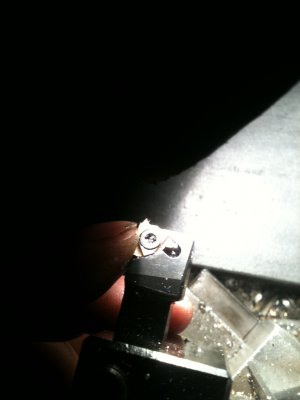Here's another little tidbit but first, let me mention these are my little tricks that work for me. There are other ways (probably better at that) to skin the cat so, I make no claim this is the right way of doing things. I will say though, my threading success rate is well upward of 97%...
First, here's another derivative formula from the first one. Lets say you have a shaft of the correct diameter that needs threading. How deep should you go? Funny you ask... OptimalThreadDepth = 1.15/(2xPitch). Now here some caveats. A) This will give a 100% engagement (which is useless and will never fit due to friction and micro-burrs). B) There is always a little tool deflection so, actual depth is often not what you dialed in. C) The starting point when the bit first makes contact is difficult to really know.
So, if for some reason you want to make a 1/4"-28 thread, take a piece of 1/4" stock, zero the crossfeed and cut until you reach 1.15/56 (equals 0.0205"). Keep in mind that with most thread cutting, a little cold-forming happens too and the diameter of the shaft as measured by reading over the threads will probably be more than what you started with. Now comes class of fit. If you want a class III (very tight tolerance fit) lookup the nominal diameter (see link for 1/4-28 3A) which is 0.2500 +/- 0.0000 and trim the OD until it's exact. -You're done and you probably have a threaded rod that will be to tight for most practical purposes.
Now let's say you want instead a class 2A (more reasonable fit). Look in the chart and trim the crests until you reach between 0.2500 and 0.2490. Take out your thread mic and read the pitch and verify it's in the tolerable range for 2A... You'll probably need to dial in a tiny bit and go a little deeper with the threads. You're done...
This is why it's so important to have a QCTP that is repeatable because in this process, you've had to swap off the toolholder to trim the OD then back to possibly adjust the threads. Also, I find it tremendously helpful to have a half decent thread mic. You can do it with wires but, be prepared to be there a while. I did it this way once/twice then bought a thread mic.
I hope this is making sense because it's a lot of words to read but, it's really easy when you think about it. Everything here also applies to internal boring... Same principles, formulas etc. Truth is, I don't do as much boring as external threading but, it all works as I've done it many, many times.
Finally, I rarely use dies and always prefer lathe cuts and obviously, for simple threaded holes, I use taps -and taps are available in different H and B (Height, Base) levels to achieve the class (B-rating) you want assuming you've bored the hole to the correct diameter. If you want any Class III B fit, you need to start with the diameter as specified from the formula from an early post. (i.e. BoreDiameter = ShaftDiameter - 1.15/Pitch). To achieve a good staring hole for a given class, use a value of ShaftDiameter in the range for that class.
http://www.engineersedge.com/screw_threads_chart.htm
Now, here's why I use those fancy little inserts. Look at the picture. This insert is designed for a particular thread (I think this one was a 13 TPI). Look at the very edge of my fingernail tip and see the leading cutting edge at the base (widest part) of the cutting edge. That little edge will start trimming the OD when you hit the right depth. Take a rod of the nominal diameter for the class fit you want and keep dialing in until you reach the desired diameter. -You're done!
I'm not sure if all inserts have this feature but, I specifically went with this brand because I had never seen it before. Maybe others have this too but the other inserts I used to use, didn't do this.
BTW, that particular insert has been used like crazy it's still sharp as heck and ready to keep going. You can't see it because of the reflection but that insert has quite a top angle for aggressive and clean cutting. You can get away with much lower RPM or, use it faster too.

Once again... Caveat Emptor. These are little tricks and formulas I figured-out myself and seem to work unwaveringly. Happy threading...
Ray



